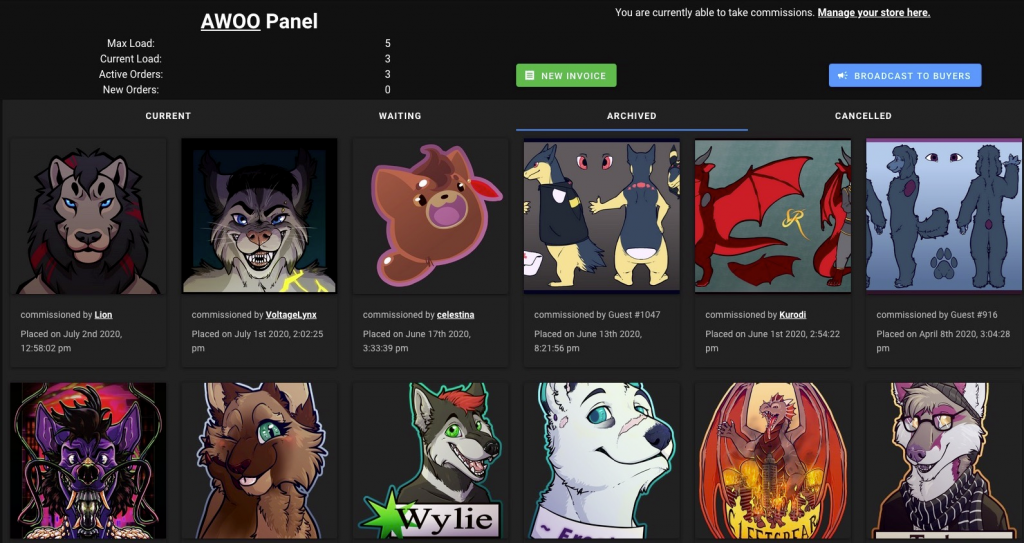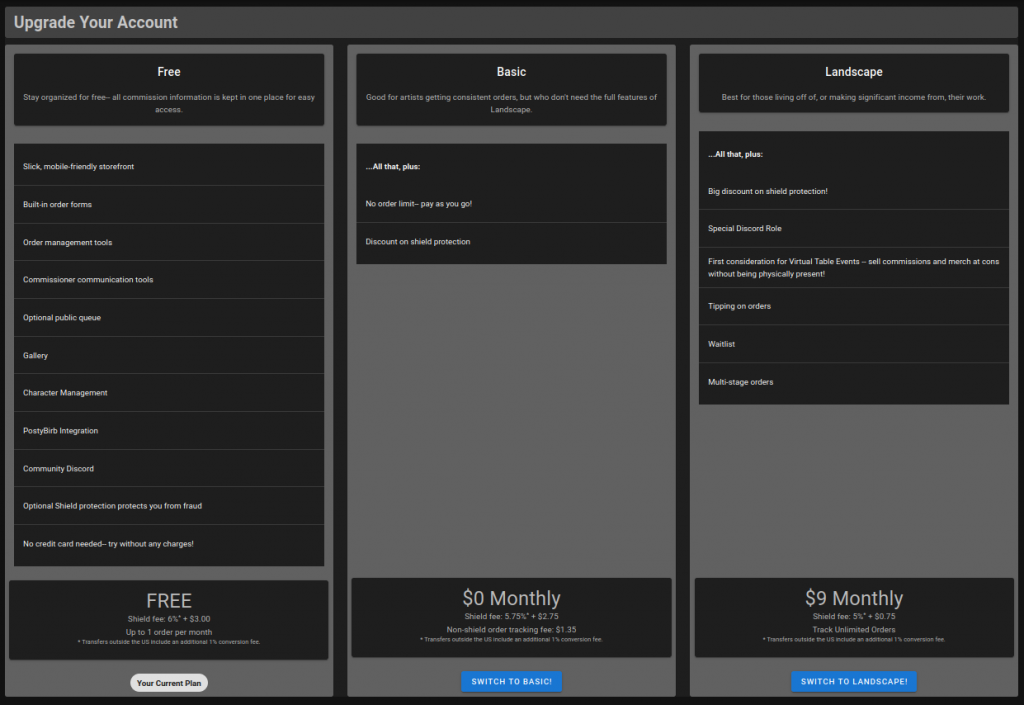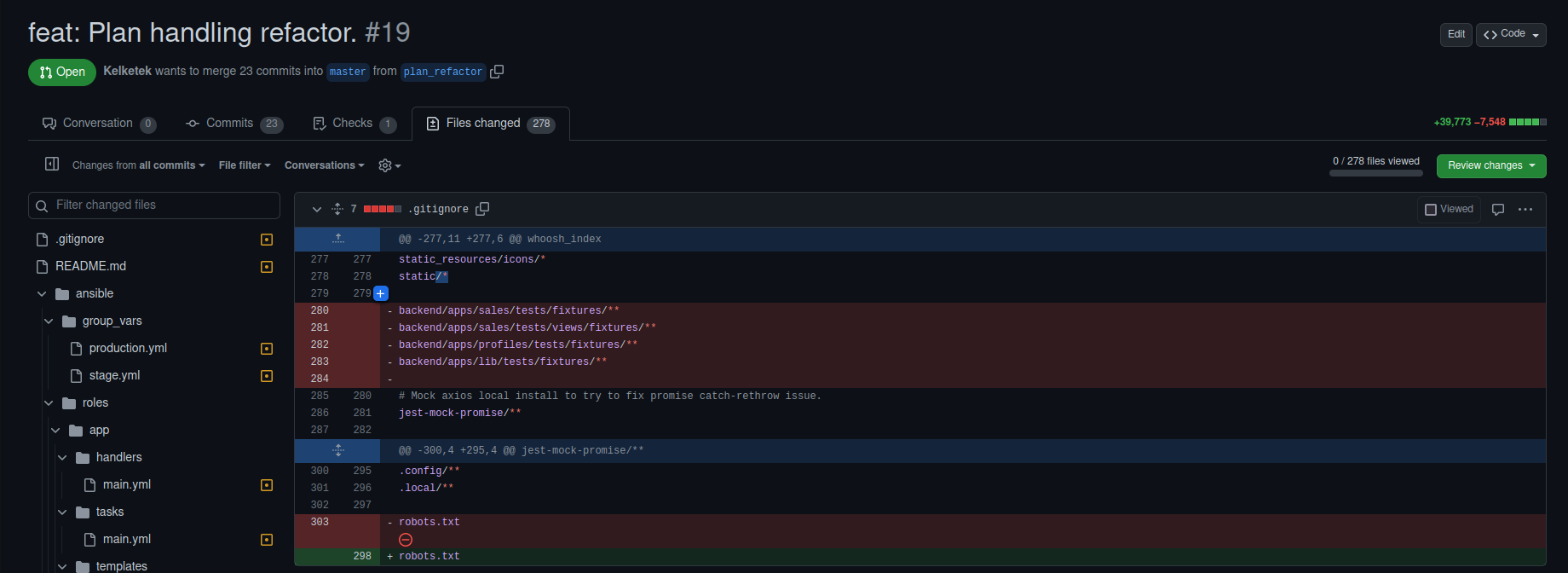Hi, all! Fox here, your friendly software architect and founder of Artconomy. We perform updates year round with improvements and features, but about once every year or two we make a major update that is the culmination of many months of work. In April, we’ll be releasing this update, and it has implications for everyone using the site.

We’ve discussed these changes on our Discord, where we solicited feedback from artists and commissioners like you!
Motivation
A couple of years ago, we had completed the changes needed to support international payments. Prior to this, Artconomy Shield was only available in the United States, limiting our ability to serve the community. Our previous payment processor was also quite opaque with their fees, levying charge after charge without clarity, making it difficult to determine how much money we were making on any particular order.
It’s difficult to plan and make decisions in your business without knowing your costs. That’s true if you’re a commission artist or a commissioning platform like us. So, the switch was welcome. However, there was a catch.
Artconomy Shield is an escrow system, and we are big fans of escrow, for many reasons. However, Stripe’s fees are different for unlocking this capability. In fact, they levy a $2 fee for every account we pay out to in a given month, even after the card transaction fees. That meant that if an artist took one commission, even with the 8% + $.75 current shield fee, we lost money unless the commission was $45 or so, and by then we’d only make a few cents.
That’s not sustainable, especially since many artists under-price themselves. We needed a new way to approach our pricing structure. And we needed it to make sense both for us and for you. We also felt that we shouldn’t do it the way some other businesses do it: By tacking on a bunch of hidden fees that surprise you. We believe our price calculator should tell you, up front, exactly how much you’re taking home, so you never wonder if you’re charging enough.

This was going to require some quite significant changes. And while one day we may be in a position to negotiate with Stripe on the fees we’re currently paying, we need a way to grow for now without the risk of closing down due to transactions costing us money on net.
Key Insights
One thing we realized is that while shield protection is great, for many artists on the platform, it’s not the most important part of Artconomy. The real value for them is that they have an easy online order system, where they can collect all the information they need about a commission and have it in one place. This makes it easy to keep track of all of their work. Artconomy’s optional public queues make it easy for commissioners to watch their piece make its way through the process.

It also makes communication easy, and with the ability to attach references and characters to an order, it’s lightyears ahead of any other system we know of for commission management.
This meant we have a significant number of artists who use Artconomy because it saves them time (and money) by allowing them to track their orders, even without shield protection. However, Artconomy is currently set up so that shield is ‘all or nothing’– either you’re onboarded with shield, and all of your products are shield protected, or you have no access to shield at all. Yes, you can mark an order as manually paid after it’s placed and forego shield, but if you’re not interested in shield, or only want it for specific orders, the site fights you.
So, we decided to greatly improve some key features of products and orders.
Listing Improvements
The first improvement is that you’ll be able to toggle shield off for particular products. Not only can you toggle shield off, you can also offer shield as an upgrade option. So, if you’d like to keep your prices and use a cheaper payment processor, you can, and then if a customer wants that extra assurance that Shield provides, they can elect to spend extra on it.

The second improvement to the order system is that you can choose to pass on all anticipated fees to the commissioner. Currently, the pricing system asks you what the final price should be, and then tells you what fees will be collected from that price. The new default will ask you what amount you want to take home, and then build the final price for the commissioner on top. You can still use the old calculation method if you want to, but we think this new method will be more popular overall.
Order Improvements
We’ve also made some significant improvements to orders. The biggest one is the ability to edit orders after they are placed. This has been a desired improvement for some time– a customer will place an order and not put in the full description, or they’ll set the content rating on the order incorrectly, causing NSFW orders to show their contents in SFW mode.
Both artists and commissioners can now edit orders up to the point of the artist marking the order as accepted, and thus ready for payment. After that point, the order’s details cannot be modified, so as to avoid a situation where someone changes something at the last moment.
Other Tweakables
Not only can you change the details of the order, artists can choose to explicitly remove or add on shield to a particular order before acceptance. You can also change the setting from absorbing the fees to passing them on, allowing you to negotiate every part of the order before accepting the order.
Line Item Calculator
The current line item handler requires you to explicity hit the save button in order to add a line item. Most of the website autosaves, so this has occasionally caused surprises for artists who thought they added a line item only to discover that they didn’t save it and undercharged their commissioner.

This has been fixed by changing how the form works, so now line items are created and saved instantly. This should make things much less confusing!
Tipping
Tipping has been available to Landscape users for a few years now. However, it had one particular irritation: You had to tip up front. This didn’t make a lot of sense– you couldn’t know how an artist would perform ahead of time. However, there wasn’t a way to make it possible before without significant changes.
Well, we’ve now made those significant changes. You can now send a tip after the order is complete to your artist!
Figuring Out the New Prices
Alright, so orders have been improved. And shield can now be offered as an optional upgrade. I mentioned that our fees had to change, so how have they?
To determine what our fees needed to be, we needed to do some math. We needed to keep track of the fees we were being given, and then figure out what we would need on top of that in order to make sure we could get paid. For transparency, let’s walk through the calculations.
Stripe charges cards at a base rate of 2.9% + $.30. And, recently, they just sent an email to all platforms letting us know it will be an additional 1.5% for every card issued outside of the US. We can’t know ahead of time whether the customer is going to be paying with an international card, so we looked at our historical data: 17% of all transactions (and transaction volume) comes from cards outside of the us. We make it an even 20% to be safe, and apply that to the 1.5, to get an additional .3%.

So now we’re at 3.2% + $.30. What else do we need to account for? Payout fees. Stripe levies a fee of .25% + $.25 for every transfer we make to an artist. So now we’re at 3.45% + $.30.
If the artist is outside of the US, Stripe levies additional currency interchange fee of up to 1%. This actually varies somewhat depending on the target country, but for many it’s 1% and it’s never more than 1%. We do know which artists are outside of the US, so we can selectively apply only this additional 1% to them.
Now there are two more fees to consider– the Stripe Radar for Teams fee, which allows us to have more advanced fraud monitoring and rules. This is an additional $.02. And then, as mentioned at the beginning of this article, Stripe charges $2 for every account we pay out to in a given month.
OK, so that’s 3.45% + $.52 for transactions to US artists, plus the $2.00 for that month, and 4.45% + $.52 for artists outside the US, also with that $2 fee.
OK. So how do we do a pricing plan that can include all those conditionals and still make sense?
The New Plans
To handle these fees, we will have three plans.

The Free Plan
The first plan is the Free plan. The free plan is the basic tier plan– everyone who isn’t on Landscape will be put onto the free plan by default. There is no monthly fee, and you can track up to one order a month, shield or non-shield. If you use shield, the fee will be 6% (down from 8%) and $3.00 (up from $.75).
This covers all of our fees and adds a little on top to help support the site’s future development and operation– AKA, hopefully allowing me to work only on Artconomy full time– doing something I love, the same dream many of the artists I serve have. 🙂
The free plan is targeted toward people using Artconomy for the first time, and those who only take a commission every so often. If you receive more than one order in a month, you’ll be prompted to upgrade to the Basic Plan, or the additional order will auto-cancel within a few days.
The Basic Plan
The basic plan is like the free plan. It also doesn’t have a monthly fee, but it does have a deliverable tracking fee. This fee $1.35 and is only for non-shield orders: At the end of the month, however many non-shield orders you tracked you’ll be billed for in one invoice. You may track as many orders as you like– pay as you go.
The shield fee also has a slight discount from free. It’s 5.75% (.25% less) + $2.75 ($.25 less). Even if you only track one order per month, you’re better off using the Basic Plan than free. So why didn’t we move everyone onto the basic plan rather than the free plan? Because anyone who wasn’t aware of the change and who tracks orders might be surprised. We didn’t want to catch them off guard with the invoice at the end of the month!
The static part of the fee is still high because there’s no guarantee that a Basic Plan user will handle enough orders to cover Stripe’s account service fee, so we have to cover it in any order. If you do more than three orders a month, you’ll almost certainly want to upgrade to Landscape.
The tracking fee on non-shield orders will help us continue to improve the experience for those orders. For instance, we’d like to eventually develop tighter integrations with other payment providers so that you can leverage most of the convenience of paying through the site, even if you’re not getting the same safety guarantees.
Landscape

Landscape is going to $9/month, up from $8. It allows you to track as many non-shield orders as you like without any additional fee, and the shield fee plummets to 5% + $.75. This is a slight increase of $.25 from the current price.
Since the monthly fee is more than enough to cover the service fee, we’re able to keep the shield fee much lower than in the other plans.
Landscape unlocks several additional features. Commissioners can tip upon a commission’s completion. Artists can make waitlisted products, or waitlist a particular order instead of accepting it or rejecting it. They can also have multi-stage orders– orders where they handle the project one section at a time (especially useful for comic pages!)
Landscape users get a special role in our Discord, and they receive one more special benefit: First access to our Virtual Table events. The Artconomy Virtual Table is a project where we book a table at a convention and sell commissions through the table while the artist stays at home. We print out the results– most commonly badges, which we can even laminate and punch right there.
Not only that, but if you can get your merch to us, we will sell it. Landscape users will always be considered first for these events, with any remaining slots (should they exist) filled by other artists on the site.
You’re Getting a Raise
With the changes in pricing, it’s clear why we needed to allow artists to decide whether to use shield on their products, offer it as an upgrade, or skip it entirely. It’s also why it’s important that artists have the option to pass on the fees rather than absorb them into their final price.
But that leaves the question– what about your current prices? If the fees are going up, and your prices are set to absorb the fees, won’t that mean you’ll get paid less than you expected when you set up your store? This could be especially bad if you didn’t read this post and give yourself time to react!
To prevent this, we’re going to be running a one-time price bump on all shielded products of $5. This should always be more than enough to cover the price changes, and then some! As soon as the deployment rolls out, the change will automatically be applied. You probably needed to raise your prices anyway, so feel free to blame it on us. 🙂
Auto-Closing
We’ve had a few cases where artists will set up shop and then abandon their orders. This is no fun– people wait around a long time and never hear back from their artist. To solve this, we’ve added auto-closure. Orders which are waiting on the artists response for several days will automatically close for inactivity, and the artist’s commissions will be marked closed so that no one else will be distracted by products which aren’t actually available.
If your commissions have been autoclosed, you can log back in and re-open them at any time. To avoid auto-closure, simply comment on the order, accept it, or reject it. Landscape subscribers can also move the order to their waitlist. Artists will be reminded about orders that are pending their response via email.
Quick Searches

You already know you can watch artists on Artconomy. You probably also know you can search submissions and products and filter them by your watch list. But we felt this could be made easier. So, we’ve added a couple of quick searches in the sidebar. Now with one click you can see all new art and all available commissions from your favorite artists! Much simpler. 🙂
Invoice Listing
To make it easier for you to find all things you’ve purchased on Artconomy, be they subscription services or commissions, or something else, we’ve added an invoice history in the settings section of your sidebar. You can look at individual invoices and see their status, and you still have access to the raw transaction data on the transaction histories pages.
Other Nerdy Details
If you’re technically minded, you might find these changes more interesting to note. Otherwise, you may wish to skip to the next section. 🙂
Full pull request here! We’ve migrated from Python 3.8 to 3.11, which contains several new features and performance improvements. We’re also upgrading to the latest Ubuntu LTS as ours is approaching end of life. Along with the LTS upgrade comes package updates to several underlying systems, like PostgreSQL and PHP/MySQL for the WordPress blog you’re reading right now.
There has been some initial work to implement a Discord bot. However I ran out of time to finish that work and so the bot doesn’t work yet, but the base code for it is in the system.
If you visit a page that is a private page for your account and you’re not logged in, you may now be redirected to log in rather than just getting an error message.
I’ve improved the documentation and automation on setting up your own copy of Artconomy locally. This should make it easier for you to play with the system and contribute changes if you see something you think could be improved.

The websockets code was greatly improved and cleaned up. Some functionality seems to have not been working right for a while, but is working again. The frontend should auto-update better now for those items websockets are tracking.
The celery async task queue now sends me alerts when a task fails. Several dependencies have been upgraded, such as Django and the Telegram bot’s API library. Test coverage has been significantly increased.
The code for Dwolla has been removed entirely, as has most of the code for Authorize.net, as we’re no longer using either of these services.
Major improvements have been made to line item calculation code, and the frontend and backend have been made much more consistent in their implementations of this code.
The code for handling invoices and payments had been made much more special. Handling deliverables/orders has become much less special cased. There are still a few places where it’s a little special– such as the API endpoint for adjusting deliverable line items.
Wrapping Up
These changes comprise some long-desired improvements, and some greatly needed ones. My hope is that Artconomy will continue to serve you and your audience as you grow. I hope to keep improving with you all on this journey!
-Fox, Artconomy.com founder


